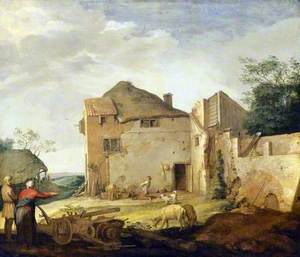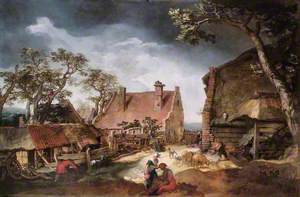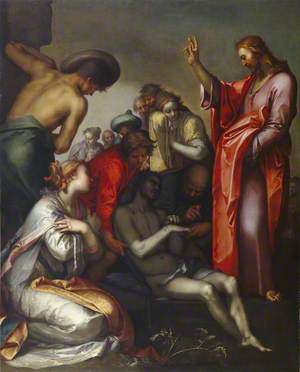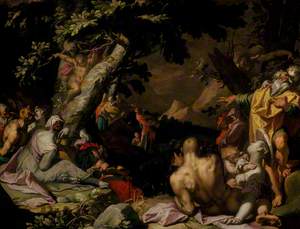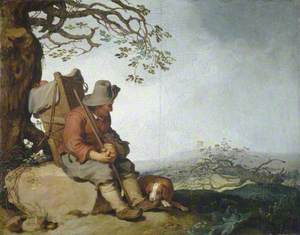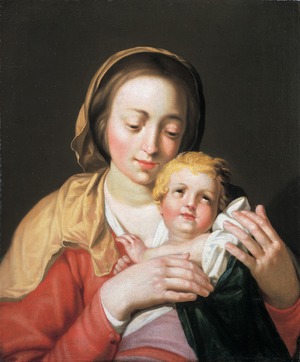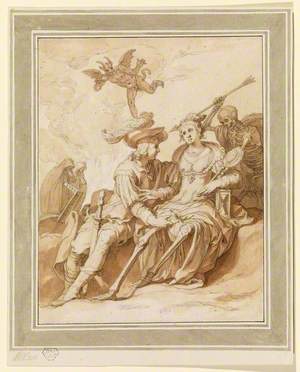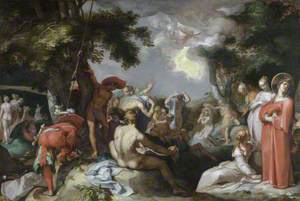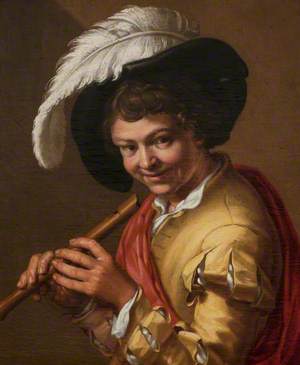- Artist: Bloemaert, Abraham, 1566–1651 Remove
- Save search
Abraham Bloemaert
1566–1651
(b Gorinchem, 25 Dec. 1566; d Utrecht, 13 Jan. 1651). Dutch figure and landscape painter and engraver, the son of a sculptor and architect, Cornelis I Bloemaert (c.
Text Source: The Oxford Dictionary of Art and Artists (Oxford University Press)
-
The Prodigal Son as a Swineherd 1637 Abraham Bloemaert (1566–1651)The Prodigal Son as a Swineherd 1637 English Heritage, Kenwood
-
Lot and His Daughters 1624 Abraham Bloemaert (1566–1651)Lot and His Daughters 1624 The National Gallery, London
-
The Prodigal Son 1615 Abraham Bloemaert (1566–1651)The Prodigal Son 1615 Leamington Spa Art Gallery & Museum
-
The Raising of Lazarus 1600–1605 Abraham Bloemaert (1566–1651)The Raising of Lazarus 1600–1605 Manchester Art Gallery
-
Miracle of the Loaves: Jesus Feeds the Five Thousand 1593 Abraham Bloemaert (1566–1651)Miracle of the Loaves: Jesus Feeds the Five Thousand 1593 National Galleries of Scotland: National
-
A Man with a Dog in a Landscape c.1630 Abraham Bloemaert (1566–1651)A Man with a Dog in a Landscape c.1630 Manchester Art Gallery
-
Virgin and Child 1625 Abraham Bloemaert (1566–1651)Virgin and Child 1625 The Schorr Collection
-
Death and the Lovers – Allegory of 'Vanitas' 1620–c.1630 Abraham Bloemaert (1566–1651)Death and the Lovers – Allegory of 'Vanitas' 1620–c.1630 The Courtauld, London (Samuel Courtauld Trust)
-
The Baptism of Christ 1595 Abraham Bloemaert (1566–1651)The Baptism of Christ 1595 National Trust, Ham House
-
Boy with a Flute Abraham Bloemaert (1566–1651)Boy with a Flute National Trust for Scotland, Brodie Castle
-
 Man with hat, scarf and stick 1601 Abraham Bloemaert (1566–1651)Man with hat, scarf and stick 1601 Aberystwyth University School of Art Museum and Galleries
Man with hat, scarf and stick 1601 Abraham Bloemaert (1566–1651)Man with hat, scarf and stick 1601 Aberystwyth University School of Art Museum and Galleries -
 Nymphs and a Satyr, possibly Pan and Syrinx | In the foreground a group of nymphs looking at a nymph who is being chased by a satyr... 1560–1651 Joachim Anthonisz. Wtewael (1566–1638) and Abraham Bloemaert (1566–1651) and Bartholomeus Spranger (1546–1611) and Hendrick Goltzius (1558–1617)Nymphs and a Satyr, possibly Pan and Syrinx | In the foreground a group of nymphs looking at a nymph who is being chased by a satyr represented at right background (descriptive) 1560–1651 Ashmolean Museum, Oxford
Nymphs and a Satyr, possibly Pan and Syrinx | In the foreground a group of nymphs looking at a nymph who is being chased by a satyr... 1560–1651 Joachim Anthonisz. Wtewael (1566–1638) and Abraham Bloemaert (1566–1651) and Bartholomeus Spranger (1546–1611) and Hendrick Goltzius (1558–1617)Nymphs and a Satyr, possibly Pan and Syrinx | In the foreground a group of nymphs looking at a nymph who is being chased by a satyr represented at right background (descriptive) 1560–1651 Ashmolean Museum, Oxford -
 A miracle with a monk (St Philip Benizzi) causing water to flow 1570–1630 Abraham Bloemaert (1566–1651) and Antonio Tempesta (1555–1630)A miracle with a monk (St Philip Benizzi) causing water to flow 1570–1630 Ashmolean Museum, Oxford
A miracle with a monk (St Philip Benizzi) causing water to flow 1570–1630 Abraham Bloemaert (1566–1651) and Antonio Tempesta (1555–1630)A miracle with a monk (St Philip Benizzi) causing water to flow 1570–1630 Ashmolean Museum, Oxford -
 St Anthony in his Study 1620 - 1630 Abraham Bloemaert (1566–1651)St Anthony in his Study 1620 - 1630 Ashmolean Museum, Oxford
St Anthony in his Study 1620 - 1630 Abraham Bloemaert (1566–1651)St Anthony in his Study 1620 - 1630 Ashmolean Museum, Oxford -
 The Adoration of the Shepherds 1618 Abraham Bloemaert (1566–1651)The Adoration of the Shepherds 1618 Ashmolean Museum, Oxford
The Adoration of the Shepherds 1618 Abraham Bloemaert (1566–1651)The Adoration of the Shepherds 1618 Ashmolean Museum, Oxford -
 Sanctus Antonius 1610 - 1620 Abraham Bloemaert (1566–1651)Sanctus Antonius 1610 - 1620 Ashmolean Museum, Oxford
Sanctus Antonius 1610 - 1620 Abraham Bloemaert (1566–1651)Sanctus Antonius 1610 - 1620 Ashmolean Museum, Oxford -
 Portrait of Vertumnus and Pomona 1605 Abraham Bloemaert (1566–1651)Portrait of Vertumnus and Pomona 1605 Ashmolean Museum, Oxford
Portrait of Vertumnus and Pomona 1605 Abraham Bloemaert (1566–1651)Portrait of Vertumnus and Pomona 1605 Ashmolean Museum, Oxford -
 Elijah and the Widow of Zarephath 1590–1670 Abraham Bloemaert (1566–1651)Elijah and the Widow of Zarephath 1590–1670 Ashmolean Museum, Oxford
Elijah and the Widow of Zarephath 1590–1670 Abraham Bloemaert (1566–1651)Elijah and the Widow of Zarephath 1590–1670 Ashmolean Museum, Oxford -
 Studies of four hands and four heads Abraham Bloemaert (1566–1651)Studies of four hands and four heads The Fitzwilliam Museum
Studies of four hands and four heads Abraham Bloemaert (1566–1651)Studies of four hands and four heads The Fitzwilliam Museum -
 Three studies of heads, two of hands and a foot Abraham Bloemaert (1566–1651)Three studies of heads, two of hands and a foot The Fitzwilliam Museum
Three studies of heads, two of hands and a foot Abraham Bloemaert (1566–1651)Three studies of heads, two of hands and a foot The Fitzwilliam Museum
